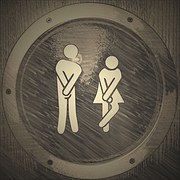Overflow Incontinence in Men
Men who are unable to completely empty their bladder and experience unexpected urine leakage may have what is called overflow incontinence. Men with this type of urinary incontinence often do not feel that their bladders are full, which then leads to leakage as the bladder has reached its full capacity. In addition to leakage, urine left in the bladder can lead to urinary tract infections due to the growth of bacteria as well as bladder stones.
Overflow incontinence is more common in men rather than women, with the leading cause being an enlarged prostate or BPH.
Symptoms
- Your bladder is never completely empty
- Frequent need to urinate day or night
- Inability to urinate when you feel the urge
- Urine leaks even after voiding
Causes
Overflow incontinence is usually caused by a blockage or nerve damage created by one of the following:
- BPH/enlarged prostate – An enlarged prostate can interfere with the passage of urine through the urethra, the tube connected to the bladder.
- Damage to nerves near the bladder causing under-activity. This can occur with neurological injury or with diseases such as diabetes.
- Urinary stones or bladder cancer.
- Side effects from medication.
- Weak bladder muscles which lead to the inability to empty the bladder completely.
Diagnosing Overflow Incontinence
 In addition to a physical exam, your doctor will ask you a series of questions
about your voiding habits and symptoms. Your doctor may order additional
diagnostic tests such as:
In addition to a physical exam, your doctor will ask you a series of questions
about your voiding habits and symptoms. Your doctor may order additional
diagnostic tests such as:
- Pelvic ultrasound: This test checks for structural abnormalities of the lower urinary tract and can assess for bladder abnormalities.
- Post-void residual test (PVR): Determines how well you empty your bladder by measuring residual urine after voiding. Measuring residual urine may aid your doctor in determining if there is a blockage or nerve or muscle problem.
- Cystoscopy: A small camera called a cystoscope is inserted into the urethra to inspect the urethra, prostate and bladder for any visual abnormalities. This procedure can be performed in your doctor’s office or ambulatory surgery center under topical local anesthesia.
- Urinary stress test: Looks for leaking urine when you cough, laugh or put other types of pressure on your bladder.
- Cystogram: A special X-ray of your bladder taken while filling and evacuating.
- Bladder stress test, which checks the loss or leakage of urine when pressure such as a cough is applied.
- Catheterization: After emptying the bladder, a catheter is inserted into the urethra to see if additional urine is present in the bladder or if leakage occurs.
- Urinalysis and urine culture, which checks urine for the presence of infection or abnormalities.
- Urodynamic testing: Your doctor may order these specialized tests that measure bladder contractions and pressure, urine flow and leakage.
Treatment for Overflow Incontinence
Medications
Certain medications known as alpha-adrenergic blockers can be prescribed by your doctor to help relax the muscle located at the base of the urethra, allowing urine to completely flow from the bladder.
Self-Catheterization
If medications do not help with symptoms and urine leakage, your doctor may ask you to try self-catheterization. A Chesapeake Urology continence specialist will teach you how to insert a small catheter to help empty your bladder at certain timed intervals.
Surgery
If your overflow incontinence is caused by a blockage, including an enlarged prostate, your doctor may recommend an appropriate surgical procedure to help alleviate your symptoms.
